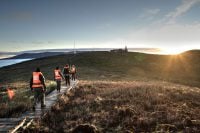A classic road trip that has grown in popularity as a unique, adventurous way of visiting Argentina, Ruta 40 or Route 40 is one of longest in the world – and one of the most sensational. By hiring a car and driving it yourself, or even taking the buses that now travel most of the distance, it’s possible to embark upon an extraordinary 3,107-mile (5,000km) adventure where you’ll encounter the diverse, wild landscapes that stretch the length of this country.
What makes Ruta 40 so spectacular?
Known locally as La Cuarenta (The Forty), Route 40 snakes from La Quiaca in the northernmost province of Argentina, to Cabo Virgenes in the far south. Skirting the edges of the Andes for the most part, this road introduces visitors to a wealth of natural landmarks including an abundance of mountains, lakes and wind-ravaged pampas, 20 national parks and hundreds of communities. To get a real sense of its epic length, Ruta 40 makes its way through 11 provinces and a distance almost equivalent to driving from San Francisco to Boston.
Key stops on Ruta 40
For those looking to experience some of Argentina’s main attractions, Ruta 40 connects most of the main towns and cities of interest when traveling through the country.
Northern Argentina
In the far north of Argentina, experience life in the harsh altitudes of the altiplano as the road passes close to Salinas Grandes, the second largest salt flat in the world. Soon after, Route 40 breaks records by reaching the breathtaking height of 16,600 ft. (5,061m) above sea level – the highest point on a national road anywhere in the world.

Along this stretch, be prepared for landscapes that merge between flamingo-filled lagoons and towering, gently smoking volcanoes.
Central Argentina
From here, Ruta 40 passes through globally-renowned wine region, Mendoza, where hot days can be spent drinking inviting glasses of the nation’s favorite, malbec, or dining on luxurious terraces surrounded by uninterrupted vistas of vineyards.
750-miles (1,220km) further south, spend a few days in Bariloche as Ruta 40 enters Argentine Patagonia and discover the region’s unique Swiss and German character, present in everything from the architecture to the chocolate. For the best views of the city and the surrounding watery landscapes of Nahuel Huapi National Park, stretch your legs with a hike along trails leading up to the area’s most distinctive mountain, Cerro Catedral.
Southern Argentina
As Ruta 40 enters the south, stop off at the Cave of Hands to admire the ancient paintings of the ancestors of indigenous people who once lived in the region, before continuing along spectacular Route 40 to stop off at El Chaltén, Argentina’s self-proclaimed hiking capital.

Here, the distinctive, soaring peaks of Monte Fitz Roy and the iceberg-riddled waters of Laguna de Los Tres are some of the stars of the Santa Cruz Province. In nearby El Calafate, be awestruck by the groaning, cobalt blue glacier, Perito Moreno – one of Argentina’s undisputed highlights.
Finally, Route 40 skims the Chilean border through deserted Patagonian steppe to end at Cabo Virgenes lighthouse and views across the Atlantic Ocean.
Travel advice for Ruta 40
What was once a real remote adventure has become a far safer and more accessible – if still unusual – way of exploring Argentine Patagonia. Ruta 40 is the ultimate road trip and vehicles can be rented to self-drive, although some buses do operate along stretches of the road.
If you’re thinking of traveling along Ruta 40:
- Most tourists choose to travel Ruta 40 between November and March as this is when most accommodations are open, particularly in the very south of Argentina where poor weather can make driving difficult during the winter.
- If hiring a car to traverse Route 40, serious planning is required. Vast distances between towns require you to organise your fuel, accommodation and food well in advance.
- A lot of the road is unpaved so ensure that your hire car has a fully-operational spare wheel as the gravel surface can lead to punctures.
- Some cash machines along stretches of the road do not accept foreign credit cards so travelling with money (mostly in the form of US dollars which you can often exchange in big cities for a reasonable rate) is the best idea.
No comments yet
There are no comments on this post yet.






Leave a comment